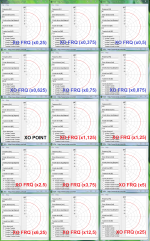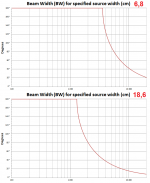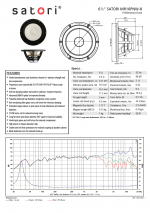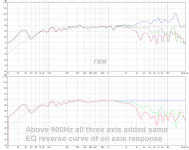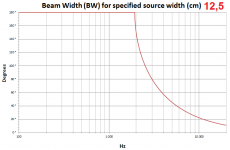...I'll have to download that app and try some simulations at 1.75 wavelengths. I'm sure it won't look pretty, even with 4th order!
(Edit: how are you entering the filter type into the app ? Or are you calculating the phase and amplitude of a given filter response elsewhere and manually entering it ?)...
Admit it was a lot of work but its free tool so can accept that and its interesting stuff to get a feel about vertical acoustics. For task luckily i have a dual flat screen desktop with two 24 inch panels where one is in landscape mode and the other is tilted to portrait mode, then have XDir open up fifteen times on portrait mode screen and free Rephase maximized on landscape screen where slopes are set and one can read out the various points of amplitude and phase and type them numbers into those fifteen XDir windows. If you haven't any dual screen computer suggest run Rephase maximized on one computer to read out slope numbers and some multiple XDir on another computer and end assemble all the XDir windows into a photo editor. That said a thought is it looks new XSim from bwaslo in 3D have some new polar features that maybe is better or easier than above method, but at present can't say because haven't tried out that 3d version yet.
It was from same XDir exercise discovered that a LR16 (96dB/oct) slope combined 1/8 wavelength would give close to real coxial performance polars as seen below
Attachments
Last edited:
Good question. Actually, you can't hear ringing (FR plot) any more than you can hear beaming (polar plot). Both exist as visual aberrations on plots.
B.
I beg to differ! Since 80-90% of the sound reaching our ears is from off-axis angles, it seems absurd to believe that polar response would not be audible. Ringing could be masked, but polar response is not simply a "visual aberration"!!!
I beg to differ! Since 80-90% of the sound reaching our ears is from off-axis angles, it seems absurd to believe that polar response would not be audible. Ringing could be masked, but polar response is not simply a "visual aberration"!!!
I think you are having trouble separating the bird's eye view (engineer) from the worm's eye view (with apologies, the listener).
Easier for me to try to explain about polar response and beaming than about ringing. A person can say, "Golly, when I sit in middle of room, the sound is wonderfully bright but duller when I sit at the sides." And they can sometimes correctly THINK that's due to beaming.
But no person can say, "Golly, I hear beaming" except as a kind of unhelpful shorthand for what I said in the previous paragraph. Well, they can say it, but it doesn't mean any more than saying, "Golly, I hear aluminum in the cone."
B.
Last edited:
There have been much instances where the sound image can shift and change significantly with a slight shift of head location. Just recently visited a new recording studio close by to understand more about how things work. While listening in a control room using ATC speakers, we started listening at different positions right behind the controlling seat, nothing special, nothing to like from a pure listening point of view. Then I sat in the controlling seat as recommended by the owner, suddenly the singer stood out and the band moved back! You had to have you head in that dead center, slight shift and the effect was lost. While the sound resolution did not meet my liking, I could understand how such a dry sound could help when making some adjustments in mixes, but still not the performance I could buy into.
Did I hear beaming? I really cannot say. Normally I would have to measure speakers that really beam then listen to them so have a good feeling what it sounds like, but I have never done such.
Did I hear beaming? I really cannot say. Normally I would have to measure speakers that really beam then listen to them so have a good feeling what it sounds like, but I have never done such.
High frequency beaming of a driver is easy to hear - from one specific listening location you may not notice it except as a general lack of high frequency ambience in the room (poor room power response in the high frequencies) but as soon as you move around a bit you can quickly assess whether a speaker is beaming or not by the change in high frequency response off axis.There have been much instances where the sound image can shift and change significantly with a slight shift of head location. Just recently visited a new recording studio close by to understand more about how things work. While listening in a control room using ATC speakers, we started listening at different positions right behind the controlling seat, nothing special, nothing to like from a pure listening point of view. Then I sat in the controlling seat as recommended by the owner, suddenly the singer stood out and the band moved back! You had to have you head in that dead center, slight shift and the effect was lost. While the sound resolution did not meet my liking, I could understand how such a dry sound could help when making some adjustments in mixes, but still not the performance I could buy into.
Did I hear beaming? I really cannot say. Normally I would have to measure speakers that really beam then listen to them so have a good feeling what it sounds like, but I have never done such.
It's definitely not something that is "just a visual aberration on a plot". As a fan of large full range drivers I'm acutely aware of what high frequency beaming sounds like and it's the main reason why I tend to fall back to using a (large) full range driver with a tweeter, much to the chagrin of full range purists I'm sure.
A really top notch full range driver can have remarkably good high frequency response that does not require a tweeter and sounds very good - but only on axis. As soon as you move your head out of the vice the results suffer. And nothing can be done about the poor power response at high frequencies that can cause the room to sound unnaturally dead in the treble whilst simultaneously very live at lower frequencies.
This dissonance between the room sounding live at lower frequencies (midrange and down) and dead at high frequencies can become tiring and unnatural after prolonged listening, particularly because the on axis treble response has to be tipped upwards to compensate for the poor power response to get a (very room dependent) subjective balance.
Last edited:
A really top notch full range driver can have remarkably good high frequency response that does not require a tweeter and sounds very good - but only on axis. As soon as you move your head out of the vice the results suffer. And nothing can be done about the poor power response at high frequencies that can cause the room to sound unnaturally dead in the treble whilst simultaneously very live at lower frequencies.
My Jordan Eikonas have a rising response on axis, I listen off axis and the response is very smooth
My Jordan Eikonas have a rising response on axis, I listen off axis and the response is very smooth
I used to do the same with my Coral drivers when I was using them in full range mode - the treble had to be tilted up about 6dB on axis then turn them about 10-15 degrees away from the listener for a good subjective balance.
A very good result on some music with pin point imaging but I do tire of the slightly unnatural lack of treble ambience in the room, and it's still head in vice positioning to get the best results, so not very good for more casual listening at different seating locations around the room. Move even one person sideways on the main sofa and the result is sub par.
The result with the same driver with a carefully crossed over ribbon tweeter has a massively larger listener sweet spot and more natural room ambience across the spectrum, and I prefer the overall result. It took a lot of work to get the driver integration in the crossover spot on though to get close to the natural coherence of the original single driver.
Last edited:
A lot of people are having trouble understanding the simple point I am making: you don't hear beaming, you hear sound.High frequency beaming of a driver is easy to hear - from one specific listening location you may not notice it ...
When you sit in your chair, the speaker is playing at you, not beaming at you. If you like the sound it also possibly measures flat, assuming your house curve is flat. If you change chairs, the treble might change due to a poor polar plot (AKA beaming).
Beaming per se isn't a problem. In devising a system, you make a call about how much beaming works well for you and in terms of the size of your listening audience, room acoustics, furnishings (and how they are distributed around your room and esp. on walls), how loud your speakers can play, ability to EQ, etc. and in terms of the trade-offs otherwise (such as complexity, cost, fuss, WAF...).
At one extreme, you can choose to accept a lot of beaming if it results in good sound at your chair, even if nowhere else in the room. That's not uncommon for people using large panel speakers or horns.
In practice, when fine-tuning your system, you set up your mic and run REW. What is, is what is.
B.
Last edited:
Yes, I find the sweet spot is still quite small. I use them OB (with woofers) and have high frequency hearing loss, so doubt tweeters would be worth it for me.A very good result on some music with pin point imaging but I do tire of the slightly unnatural lack of treble ambience in the room, and it's still head in vice positioning to get the best results, so not very good for more casual listening at different seating locations around the room. Move even one person sideways on the main sofa and the result is sub par.
But you do hear beaming - as a deadness and lack of room ambience at high frequencies. Even if you sit in the sweet spot.A lot of people are having trouble understanding the simple point I am making: you don't hear beaming, you hear sound.
That is my primary problem with the pure full range experience. I don't mind sitting in exactly one location for "serious listening" to get the ideal response, but that ambience deadness at high frequencies can't be solved with a beaming driver.
If the driver is truly beaming at high frequencies (we're talking about less than about 20 degrees coverage here) then the on axis response to get a subjectively balanced response is neither flat, nor a sloping down "house curve", but requires the treble to be tilted up quite significantly - on the order of around 6dB or more. This can become fatiguing over time.When you sit in your chair, the speaker is playing at you, not beaming at you. If you like the sound it also possibly measures flat, assuming your house curve is flat.
I think you may have a different definition of beaming than other people. We're not talking about somewhat reduced dispersion of say 90 or 60 degrees, we're talking about tightly focused dispersion <20 degrees or so.Beaming per se isn't a problem. In devising a system, you make a call about how much beaming works well for you and in terms of the size of your listening audience, room acoustics, furnishings (and how they are distributed around your room and esp. on walls), how loud your speakers can play, ability to EQ, etc. and in terms of the trade-offs otherwise (such as complexity, cost, fuss, WAF...).
DBMandrake wrote:
The main disadvantage of a high order filter though is the ringing that it introduces at the crossover frequency. The higher the order the more it rings, and of the classic minimum phase filter topologies only the 1st order doesn't ring.
This is new to me, please tell more about ringing! How does it sound? How does it show up in measurements? My guess is that this is some interference. How can we test it, playing sine at Fxo?
A filter is basically a resonant circuit which can with the application of enough input power be driven into self-oscillation.
This is more evident in analogue synths because in their case self-oscillation is a good thing to achieve those screaming synth lead lines. But of course the onset is gradual from just pure filtering at the set frequency up to the point when all input energy is converted to oscillation at set frequency which in a crossover would be the crossover freq. ie given enough energy a crossover will eventually just howl at the set frequency.
The higher the filters order the easier it is to get the oscillation going with 6dB filters never getting there.
Either way in synthesizers this is a desirable feature while in a crossover it is an annoying fault.
High frequency beaming of a driver is easy to hear - from one specific listening location you may not notice it except as a general lack of high frequency ambience in the room (poor room power response in the high frequencies) but as soon as you move around a bit you can quickly assess whether a speaker is beaming or not by the change in high frequency response off axis.
It's definitely not something that is "just a visual aberration on a plot". As a fan of large full range drivers I'm acutely aware of what high frequency beaming sounds like and it's the main reason why I tend to fall back to using a (large) full range driver with a tweeter, much to the chagrin of full range purists I'm sure.
A really top notch full range driver can have remarkably good high frequency response that does not require a tweeter and sounds very good - but only on axis. As soon as you move your head out of the vice the results suffer. And nothing can be done about the poor power response at high frequencies that can cause the room to sound unnaturally dead in the treble whilst simultaneously very live at lower frequencies.
This dissonance between the room sounding live at lower frequencies (midrange and down) and dead at high frequencies can become tiring and unnatural after prolonged listening, particularly because the on axis treble response has to be tipped upwards to compensate for the poor power response to get a (very room dependent) subjective balance.
Actually I am using a 3” full range driver that works quite well, I do not sense much off center image shifts, but it would be interesting to plug into a studio and compare. This design was due to a dust cap design change which also reduced beaming but did require an EQ circuit somewhat like OS wave guides. For larger full range drivers, cone shape design is also important.
While I do understand the room has large influence, but this does not change the improvement necessary in driver and loudspeaker design as well as other parts of the playback system.
However crossovers don't just work in the electrical domain, they also work in the driver and acoustic domains, which adds extra dimensions of complexity to the problem...
Well said, totally agree with the above, thanks for posting.
...As a fan of large full range drivers I'm acutely aware of what high frequency beaming sounds like...
In second below had some fun in Rephase EQ raw curve flat on axis above 900Hz and see how that same EQ looked for 30º and 60º axis and in third below theoretical it looks pass 60º point a little lower than 4kHz and below 20º looks happen above 11kHz.
Attachments
A filter is basically a resonant circuit which can with the application of enough input power be driven into self-oscillation.
This is more evident in analogue synths because in their case self-oscillation is a good thing to achieve those screaming synth lead lines. But of course the onset is gradual from just pure filtering at the set frequency up to the point when all input energy is converted to oscillation at set frequency which in a crossover would be the crossover freq. ie given enough energy a crossover will eventually just howl at the set frequency.
The higher the filters order the easier it is to get the oscillation going with 6dB filters never getting there.
Either way in synthesizers this is a desirable feature while in a crossover it is an annoying fault.
This is not actually correct. If the filter is linear then if it does not oscillate at low levels then it cannot oscillate at high levels either. No amount of power input can cause it to oscillate, its not dependent on the power level. For the most part filters used in audio are linear and stable up to any level that they are likely to ever see. Filters are resonant devices, but this is much different than oscillating.
This is not actually correct.
Fair enough, I assumed they were oscillating since I sometimes use an overdriven filter as a tuneable oscillator in my analogue synth.
Hey all,
Question:
I have a JBL 2452SL on a JMLC 350hz horn which crosses over nicely at 550hz. I plan to change the horn at some point in the future. (but this is a discussion for another time)
Due to changing room design plans, I purchased a AE TD10M driver for the bass, as (at the time) all I had room for was a 10" bass driver, and this was the best I could get.
Well, I now have room for almost anything, as the speakers are going in wall.
But am stuck on my choices.
I happen to have a pair of 18" JBL 2242H drivers laying about, and had never considered using them as bass drivers in a speaker rather than as subs until a friend asked about them.
I also have a friend who would like to buy them, so instead have the option to swap over to the newer JBL2268's.
I have found reference to the 2242H drivers highest crossover frequency being 1khz, so amazingly they should be good up to my crossover point of 550hz.
I cannot find any good data comparing the 2242 and the 2268 and the TD10M for distortion. Is a 2242 a significantly lower distortion driver to a TD10M? And is the 2268 better or not?
Max SPL use is about 115db, so this is a quality rather than pure SPL application (home cinema/stereo)
General thoughts welcome!
Question:
I have a JBL 2452SL on a JMLC 350hz horn which crosses over nicely at 550hz. I plan to change the horn at some point in the future. (but this is a discussion for another time)
Due to changing room design plans, I purchased a AE TD10M driver for the bass, as (at the time) all I had room for was a 10" bass driver, and this was the best I could get.
Well, I now have room for almost anything, as the speakers are going in wall.
But am stuck on my choices.
I happen to have a pair of 18" JBL 2242H drivers laying about, and had never considered using them as bass drivers in a speaker rather than as subs until a friend asked about them.
I also have a friend who would like to buy them, so instead have the option to swap over to the newer JBL2268's.
I have found reference to the 2242H drivers highest crossover frequency being 1khz, so amazingly they should be good up to my crossover point of 550hz.
I cannot find any good data comparing the 2242 and the 2268 and the TD10M for distortion. Is a 2242 a significantly lower distortion driver to a TD10M? And is the 2268 better or not?
Max SPL use is about 115db, so this is a quality rather than pure SPL application (home cinema/stereo)
General thoughts welcome!
Last edited:
I have a JBL 2452SL...
I happen to have a pair of 18" JBL 2242H drivers...
have the option to swap over to the newer JBL2268's.
Is a 2242... lower distortion driver to a TD10M? And is the 2268 better or not?
I also have JBL 245x compression drivers, currently paired with JBL 2226 (15") woofers and 2245 (18") subwoofers.
It has occurred to me that JBL 4" voice coil comp. driver could play sufficiently low to cross directly to an 18" so yeah, I think it could work for a driver like the 2242 that doesn't break up too low.
The 2268 is quite a close replacement for the 2242 in most parameters so it should work too, I haven't looked at break up of the 2268 but I expect it's similar.
The more symmetrical dual differential voice coil of the 2268 should have lower 2nd harmonic distortion but it probably hardly matters in a domestic installation, should be practically inaudible for either driver at any tolerable level.
I think the main improvement of the later driver is simply that it's less massive, nice for a tour sound speaker but mostly irrelevant for your use.
So I would sell the 2242s and replace with 2268 only if the swap-over cost is small.
The AE is nice but wouldn't be my choice, unless maybe it has the Apollo enhancement.
Best wishes
David
- Home
- Loudspeakers
- Multi-Way
- Who makes the lowest distortion speaker drivers
